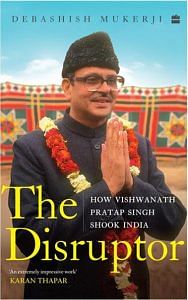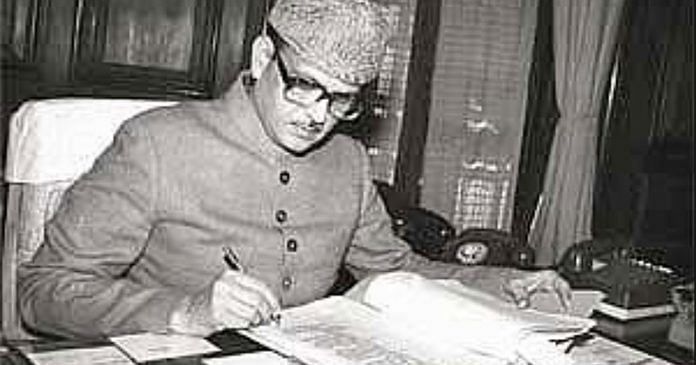In the 1996 general election, the BJP’s seat tally, for the first time, surpassed the Congress’s, reaching 161 of the 543 seats while the Congress’s fell to 140 and the Janata Dal managed 46. The Janata Dal’s National Front partners, however, unlike in the last two Lok Sabha polls, performed admirably this time in their respective states, bringing in another 58 seats. The DMK in Tamil Nadu, in particular, after failing to get any seats in the 1989 and 1991 general elections, captured (in alliance with another regional party) 37 of the state’s 39 constituencies. With the Left Front adding another 48 seats, the total National Front–Left Front tally, too, surpassed the Congress’s. Most of the other unaffiliated smaller parties that had won the remaining seats also disdained backing the BJP. Within days of the poll results being declared on 10 May 1996, all of them thus bandied together to expand the National Front–Left Front into a thirteen-party United Front, which among them held a total of 192 seats.
To keep the BJP out of power, the Congress also added its 140-seat tally to the United Front’s, agreeing to support the alliance from outside, giving it an obvious majority of 332 out of 543 seats. But who would be Prime Minister if this hybrid combination took over? Very few among the elected MPs of the United Front had national stature. Some of the better-known chief ministers of states were considered, but they either refused or their parties’ other leaders would not let them shift to the Centre. By the night of 13 May 1996, the United Front leaders reached a consensus—though he had neither contested the 1996 election nor campaigned in it, VP was the only possible candidate. After he left 7, Race Course Road, having quit as Prime Minister, VP had moved back into the 1, Teenmurti Marg bungalow he had earlier occupied as finance minister (and where he would stay for the rest of his life), which the MP occupying it obligingly vacated for him.
On the morning of 14 May 1996, two chief ministers were at his door, insisting he become Prime Minister again. (All the chief ministers of the parties supporting the United Front had arrived in Delhi to finalize their government.) VP refused. The two chief ministers said they would be back at 4 p.m. with more persuaders. But VP’s mind was made up.
‘I was determined to refute those who had called me power-hungry when I had agreed to become Prime Minister (in December 1989), after having said during the election campaign that I wouldn’t accept the position,’ he said. ‘I had taken up the job then only because I was pressured.’
Also read: It’s a puzzle why VP Singh was never accepted by OBCs even after Mandal Commission
Recalling the day’s drama, Sita Kumari was more matter-of-fact. ‘I, too, didn’t want him to become Prime Minister again, as I knew his health could not take the strain,’ she said. ‘Besides, everyone knew the Congress’s record of supporting other parties— the support would inevitably be withdrawn sooner rather than later.’ VP decided that he did not want to meet (or even speak to) the United Front leaders again, until they had chosen someone else as their new Prime Minister—he would find it impossible to resist if they all pressured him together.
Pure farce followed as, soon after lunch, he left home, while a whole posse of the leaders—including eight chief ministers—arrived barely an hour later, looking for him. VP first went to the Kailash Colony apartment he owned for his vital post-lunch nap but realized he could easily be tracked there. He visited a close friend in east Delhi, a bureaucrat uninvolved in politics, hoping he could remain untraced at his home, but by then, the Opposition leaders had alerted the police and their journalist friends, who had also begun searching for him. With his SPG escort staff required to continuously update their bosses of their movements on wireless, VP’s whereabouts were soon established.
‘My friend made tea, but I had barely taken my first sip when the press was at his door,’ he said. ‘I left in a hurry and told my driver to simply keep the car moving along Delhi’s Ring Road.’ The few among VP’s SPG security men, who had been left behind at his home, got in touch with their counterparts travelling with him via wireless, saying that the Opposition leaders were urging them to find out where he was.
‘You can tell them,’ VP said. He figured that if the car kept moving, they would still not be able to catch him. ‘It was a weird situation, with the chief ministers, their security staff and hangers-on all over the place,’ said Sita Kumari. ‘My servant boy had such a hard time, endlessly serving tea and biscuits. The SPG people kept telling me, “Madam, unko bol do na, ban jaye pradhan mantri (Madam, please tell him to become Prime Minister).”’
Also read: BJP needs to drop its hate agenda to become a normal party — what VP Singh said in 2005
VP hinted later that she had been quite annoyed. ‘I spoke to her and she said, “I don’t know what you are doing. Everyone’s asking where you are and I’m unable to tell them anything,”’ he recalled. ‘I said, “Tell them I’ll return very late.” She said, “I won’t do it. You tell them.” But I didn’t want to speak to them.’ He eventually went to Delhi airport, hoping to mislead the other leaders into thinking he was flying out, and thence to Sohna in Haryana, checking into a guest house close to the sulphur springs. Eventually, giving up, the United Front leaders left his home and, holding another meeting, chose the Karnataka Chief Minister H.D. Deve Gowda—a farmers’ leader little known outside his state at the time—as their candidate for Prime Minister. It was only after he heard this on the news on TV in his room at the Sohna guest house that VP checked out and returned home.
Briefly, it seemed as if the United Front leaders had left their decision too late. They had taken so long to choose their leader that President Shankar Dayal Sharma—who succeeded President R. Venkataraman in July 1992—had already invited the BJP (since it was the single-largest party) to form the government. But with only three small parties supporting it, raising its total strength from 161 to 195 seats, still much lower than the 272 seats (out of 543) needed for a majority, the BJP government was forced to resign after thirteen days, enabling the United Front to form the government and Deve Gowda to become Prime Minister. As Sita Kumari had predicted, the Congress allowed Deve Gowda’s rule to last a mere eleven months, after which it sought a change of leader. The United Front obliged and I.K. Gujral replaced Deve Gowda, but after another eleven months, more differences arose and the Congress withdrew support. It led to another general election in February–March 1998, after which the Janata Dal—beset by more splits by then, down to only 6 Lok Sabha seats after the poll—disintegrated completely.
 This excerpt from ‘The Disruptor: How Vishwanath Pratap Singh Shook India’, by Debashish Mukerji, has been published with permission from HarperCollins India.
This excerpt from ‘The Disruptor: How Vishwanath Pratap Singh Shook India’, by Debashish Mukerji, has been published with permission from HarperCollins India.



